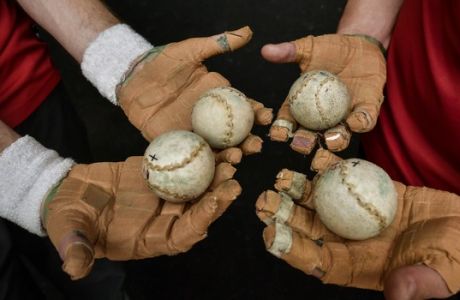H βάσκικη πελότα θυμίζει τένις και πόλεμο, χωρίς ρακέτες
Σε ένα αγώνα βάσκικης πελότας, η μπάλα χτυπάει τους τοίχους με ταχύτητα 100 χιλιομέτρων/ώρα. Ο κάθε παίκτης καλείται να σκοράρει χρησιμοποιώντας τα -σχεδόν- γυμνά του χέρια.

Υπάρχουν άνθρωποι εκεί έξω που σιχαίνονται το τένις, υπάρχουν κι εκείνοι που αντιμετωπίζουν το τένις ως ένα άθλημα γεμάτο από αναφορές σε επιστήμες όπως η φυσική και τα μαθηματικά. Ο θρυλικός συγγραφέας Ντέιβιντ Φόστερ Γουάλας είχε περιγράψει την αντισφαίριση, με ένα τρόπο που θα μπορούσε να αποτελέσει γέφυρα για να ορίσουμε και μια αρκετά πιο extreme εκδοχή της, τη Βασκική Πελότα. Ο Γουάλας στο δοκίμιο του με τίτλο 'String Theory' είχε γράψει:
"Στα αθλήματα που παίζουν άντρες, κανείς δεν αναφέρεται στην ομορφιά, τη χάρη ή τις κινήσεις του σώματος. Οι άντρες εκφράζουν την αγάπη τους για τα αθλήματα, αλλά αυτή η αγάπη συνήθως εκφράζεται με τη σημειολογία του πολέμου: πρόκριση-αποκλεισμός, στατιστικά και τεχνικές αναλύσεις, θόρυβος μέσα στο γήπεδο, πρόσωπα βαμμένα με φούμο, αθλητές που χτυπάνε με τα χέρια το στήθος τους."
Η Βάσκικη Πελότα είναι ένα άθλημα που θυμίζει μάχη: Καταρχήν, οι παίκτες δεν χρειάζονται ρακέτες, αρκούν μόνο τα χέρια τους για να χτυπήσουν μια μικρή μπάλα με σκληρό πλαστικό πυρήνα, σε ταχύτητες που μπορεί να φτάσουν και τα 110 χιλιόμετρα την ώρα. Συγκεκριμένα, οι 'Πελοτάρι' το μόνο που χρησιμοποιούν για την προστασία των χεριών τους είναι μια σφιχτά δεμένη ταινία που καλύπτει όλο το μήκος και το πλάτος της παλάμης τους, η οποία συχνά περικλείει ένα λεπτό στρώμα αφρολέξ- δίνοντας τους την ψευδαίσθηση ότι φοράνε κάτι σαν γάντια.


Το παιχνίδι αυτό θα μπορούσε να περιγραφεί και ως ένα μακρινό ξαδελφάκι του Σκουός, όμως είναι πολλά περισσότερα από μια οδυνηρή παραλλαγή της αντισφαίρισης. Πρόκειται για ένα αγώνισμα που γεννήθηκε και συνεχίζει να ζει και να εκφράζει κάθε τρελή Βάσκικη ψυχή, από τη Βόρεια Ισπανία ώς τη Νοτιοδυτική Γαλλία. Το γήπεδο λέγεται 'Fronton' και οι παίκτες μπορούν να χτυπήσουν τη μπάλα στον μπροστά, τον πίσω τοίχο, αλλά και εκείνον που βρίσκεται αριστερά τους. Ο τοίχος εκ των δεξιών τους, δεν περιλαμβάνεται στο παιχνίδι.

Στα πρώτα χρόνια της ιστορίας της, η Πελότα παιζόταν στις πλατείες των χωριών, με τον τοίχο της κεντρικής εκκλησίας να γίνεται το σημείο αναφοράς του (Αυτοσχέδιου) γηπέδου.
Σήμερα η Πελότα αναγνωρίζεται ως επαγγελματικό άθλημα και παίζεται σε αγωνίσματα μονών και διπλών, ενώ οι θεατές μπορούν να ποντάρουν και στον νικητή. Το τρόπαιο είναι ένας μεγάλος πράσινος Βάσκικος μπερές, που αποκαλείται "Txapela", ενώ ο πρωταθλητής λέγεται "Txapeldun'.

Η - χειροποίητη- μπάλα στην αρχική μορφή του αθλήματος, αποτελούνταν από ένα σκληρό πλαστικό πυρήνα, ο οποίος είναι παραγεμισμένος με έντερα γάτας και πριονίδια, ενώ το εξωτερικό του περίβλημα είναι φτιαγμένο από δέρμα προβάτου. Σήμερα παράγονται νέες μπάλες, από συνθετικά υλικά, μέσω βιομηχανικών διαδικασιών.

Η προετοιμασία ενός Πελοτάρι θυμίζει τον διαλογισμό ενός γιόγκι: Πρέπει μια ώρα πριν κάθε αγώνα να ξεκινήσει να προετοιμάζει τα χέρια του, μόνος με τον εαυτό του να διαπιστώνει πώς ούτε και σε αυτό το παιχνίδι πρέπει να τρομάξει απέναντι στον πόνο μιας μπάλας που έρχεται κατά πάνω του με ταχύτητα μπάλας κανονιού.

Κατά τη διάρκεια του παιχνιδιού τα χέρια τους θυμίζουν καταπέλτες και πολιορκητικές μηχανές, όπως εκείνες που είχαν οι Ρωμαίοι κάθε φορά που πολιορκούσαν το χωριό του Αστερίξ. Μόνο που οι ταχύτητες και η δύναμη των Πελοτάρι, μοιάζει πολλαπλάσια. Όσο για τον πόνο στα χέρια τους ύστερα από κάθε χτύπημα με την μπάλα, αυτό θυμίζει περισσότερο θύματα πολέμου από ταινίες όπως o "Στρατιώτης Ράιαν" και το "Αποκάλυψη Τώρα".

Είναι μια μάχη η Βάσκικη Πελότα, όχι ένα ακόμα άθλημα που η περιγραφή του τελειώνει σε '-σφαίριση'. Είναι μια μάχη που θα έπρεπε να βλέπουν στον ύπνο τους όλοι οι ρακετάδες που κατακλύζουν τις παραλίες κάθε καλοκαίρι. Είναι επίσης μια μάχη που μοιάζει με τη ζωή ενός Βάσκου και τον αγώνα του να αποδείξει ότι αξίζει να παλέψει για το δικαίωμα του στον φυλετικό/εθνικό αυτοπροσδιορισμό. Η Πελότα είναι ο αγώνας επιβίωσης του κάθε Βάσκου.

Φωτογραφίες: Associated Press/Alvaro Barrientos



















